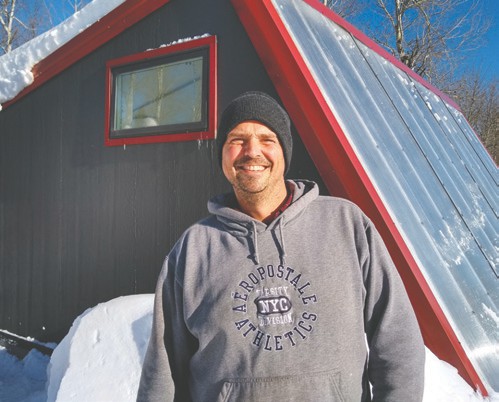Lumber, glass, big rocks, dirt, and sunshine is all you need for a Deep Winter Greenhouse (DWG), first described in a book by Carol Ford and Chuck Waibel in 2009 titled The Northlands Winter Greenhouse Manual.

So, what is a DWG? It is a passive solar greenhouse that captures the sun’s light and heat during the day and stores the heat it in the earth to recirculate at night. The greenhouse is oriented east-west with a large south-facing glass or polycarbonate wall built at an angle that will catch as much of the sun’s energy as possible, given the latitude. The other walls are solid and very well insulated, often with reflective interior surfaces, and the north wall is sometimes earth sheltered, if the landscape permits. It is the dirt, and sometimes gravel or large stones about four feet deep under the greenhouse, that act as a battery to store the heat that’s captured during the day. That heat is blown underground with a fan and then ducted out and up into the growing area at night. DWGs usually have a back-up heat source in case there’s prolonged cloudiness, but the stored heat from the sun usually lasts three days without recharging.
One of the challenges with building a DWG is drainage. If it is on a wet site, you have to to add fill around the insulated four-foot basement to prevent moisture from getting in. And there can be some problems with mold.
Stefan Meyer, who manages the Finland DWG, has been harvesting all winter. Lettuce, Asian Greens, salad mix, rainbow chard, napa cabbage, as well as spinach, arugula. The greens are sold at the Finland General store, the oldest Cooperative in Minnesota.
The DWG at the Bemidji Community Food Shelf is located on the food shelf farm. The farm manager and volunteers run the greenhouse and grow microgreens, radishes, chard, peas, and salad greens which are given away at the food shelf. The farm produces fresh produce for the food shelf, too. But the DWG allows production to continue all winter while the farm fields lie frozen under the snow. The food shelf is within the industrial park in Bemidji, which has a high-water table—not good for underground heat storage. They raised the foundation 12 inches, but now wish it would have been more. They installed a berm around the foundation and added insulation but keeping the rock bed dry so that it absorbs the heat optimally is an ongoing challenge. On a positive note, the Bemidji DWG has a metal exterior which has worked out very well and is maintenance-free.
Friends in Linden Grove have built a modified DWG as part of a complex that also houses their sauna, beekeeping storage room, work room, and root cellar. Their greenhouse is on the south side and its south-facing wall is polycarbonate but is built like a regular greenhouse with a vertical wall and roof rather than the full wall at a 60-degree angle that is typical of DWGs. It is built over a four-foot soil and sand heat storage area with pipes zigzagging through the sand, bringing the heat from the top of the greenhouse near the roof down into the soil/sand. This greenhouse does not have a mechanism for blowing the stored heat back into the growing area. But it stays at 40 degrees during the coldest part of winter, offering some warming to the greenhouse above.
The main benefit of this design, according to the owner, is that it can be used year-round. It has side doors that can be opened in the summer and, for added heat in the winter, the sauna vents into the greenhouse.
You can read the original article at www.hometownfocus.us

This is amazing, and in one of the coldest areas in the USA.